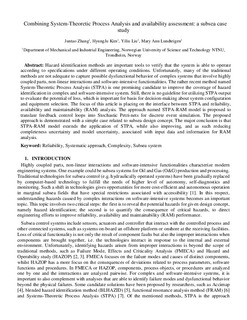| dc.contributor.author | Zhang, Juntao | |
| dc.contributor.author | Kim, Hyungju | |
| dc.contributor.author | Liu, Yiliu | |
| dc.contributor.author | Lundteigen, Mary Ann | |
| dc.date.accessioned | 2019-03-01T11:36:32Z | |
| dc.date.available | 2019-03-01T11:36:32Z | |
| dc.date.created | 2019-01-09T17:04:44Z | |
| dc.date.issued | 2019 | |
| dc.identifier.issn | 1748-006X | |
| dc.identifier.uri | http://hdl.handle.net/11250/2588236 | |
| dc.description.abstract | Hazard identification methods are important tools to verify that the system is able to operate according to specifications under different operating conditions. Unfortunately, many of the traditional methods are not adequate to capture possible dysfunctional behavior of complex systems that involve highly coupled parts, non-linear interactions and software-intensive functionalities. The rather recent method named system-theoretic process analysis (STPA) is one promising candidate to improve the coverage of hazard identification in complex and software-intensive system. Still, there is no guideline for utilizing system-theoretic process analysis output to evaluate the potential of loss, which is important for basis of decision-making about system configuration and equipment selection. The focus of this article is to place an interface between system-theoretic process analysis and reliability, availability and maintainability (RAM) analysis. The approach named STPA-RAM model is proposed to translate feedback control loops into stochastic Petri nets for discrete event simulation. The proposed approach is demonstrated with a simple case related to subsea design concept. The major conclusion is that STPA-RAM model extends the application of system-theoretic process analysis, while also improving and as such reducing completeness uncertainty and model uncertainty, associated with input data and information for reliability, availability and maintainability analysis. | nb_NO |
| dc.language.iso | eng | nb_NO |
| dc.publisher | SAGE Publications | nb_NO |
| dc.title | Combining system-theoretic process analysis and availability assessment: A subsea case study | nb_NO |
| dc.type | Journal article | nb_NO |
| dc.type | Peer reviewed | nb_NO |
| dc.description.version | acceptedVersion | nb_NO |
| dc.source.journal | Proceedings of the Institution of Mechanical Engineers. Part O, Journal of risk and reliability | nb_NO |
| dc.identifier.doi | https://doi.org/10.1177/1748006X18822224 | |
| dc.identifier.cristin | 1653578 | |
| dc.relation.project | Norges forskningsråd: 237893 | nb_NO |
| dc.description.localcode | © 2019. This is the authors' accepted and refereed manuscript to the article. The final authenticated version is available online at: https://doi.org/10.1177%2F1748006X18822224 | nb_NO |
| cristin.unitcode | 194,64,92,0 | |
| cristin.unitname | Institutt for maskinteknikk og produksjon | |
| cristin.ispublished | true | |
| cristin.fulltext | original | |
| cristin.qualitycode | 1 | |
